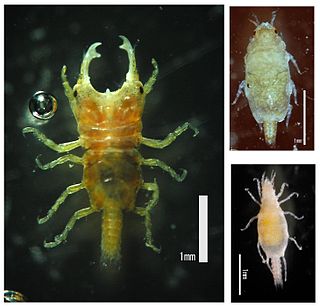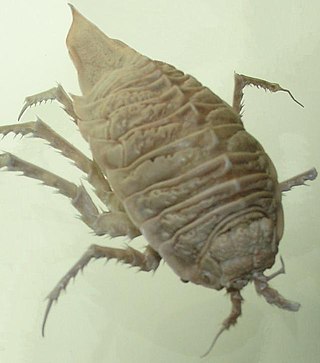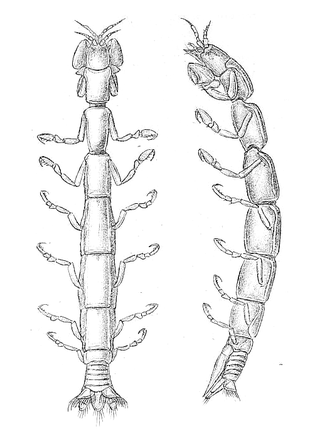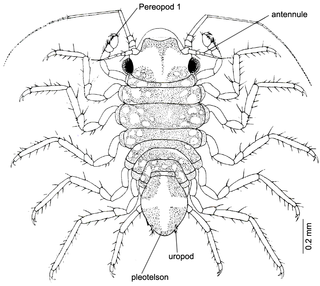
Isopoda is an order of crustaceans that includes woodlice and their relatives. Isopods live in the sea, in fresh water, or on land. All have rigid, segmented exoskeletons, two pairs of antennae, seven pairs of jointed limbs on the thorax, and five pairs of branching appendages on the abdomen that are used in respiration. Females brood their young in a pouch under their thorax.

The Gnathiidae are a family of isopod crustaceans. They occur in a wide range of depths, from the littoral zone to the deep sea. The adults are associated with sponges and may not feed. The juvenile form is known as a 'praniza', and it is a temporary parasite of marine fish. These forms are not larvae; Gnathiidae instead become parasitic during the manca stage. Mancae of the Gnathiidae closely resemble the adult form, however they lack the final pair of pereiopods.

The Valvifera are marine isopod crustaceans. Valviferans are distinguished, however, by the flat, valve-like uropods which hinge laterally and fold inward beneath the rear part of their bodies, covering the pleopods. Some species are omnivorous, and serve as effective scavengers in the economy of the sea. Eleven families are recognised:

Sphaeromatidae is a family of isopods, often encountered on rocky shores and in shelf waters in temperate zones. The family includes almost 100 genera and 619 known marine species. Within these genera, there are groups that share distinctive morphologies; further research may reclassify these genus-groups as separate families.
Ceratoserolis is a genus of isopods in the family Serolidae from the Southern Ocean around Antarctica and some Sub-Antarctic Islands. They prefer to live on soft bottoms and range of least between 24 and 950 m (80–3,120 ft) in depth. They are superficially similar to the unrelated, extinct trilobites and reach up to about 8 cm (3.1 in) in length. They were once considered to be part of the genus Serolis and for a long time only Ceratoserolis trilobitoides was recognized. The validity of the other species has been disputed, but there are some morphological and genetic differences between them and C. trilobitoides, and there are indications that additional, currently unrecognized species of Ceratoserolis exist.
Nichollsia is a genus of isopod crustaceans from India. It comprises two species:

Anthuroidea is a superfamily of isopod crustaceans, formerly treated as a suborder, Anthuridea. The group is characterised by "an elongate cylindrical body form, without dorsal coxal plates, and with a uropodal exopod attached to the peduncle proximally and dorsally". There are more than 500 described species in 57 genera, arranged across six families:
Iais is a genus of isopod crustaceans. Iais species are found in association with larger isopods of the family Sphaeromatidae, usually on the ventral surface of the larger animal, between the pereiopods and on the pleopods. They are native to Australasia and South America, although Iais californica and its host Sphaeroma quoyanum have invaded California, and I. californica was first described from Sausalito, California. Nine species are recognised:
The Microcerberidea are a suborder of isopod crustaceans. They are less than 2 mm (0.079 in) long, and live interstitially. They may be found in the eastern Pacific Ocean, and around the coasts of South America, Africa, the Mediterranean Sea, and India.

Gnathia is a genus of isopod crustaceans, containing the following species:

Agnaridae is a family of woodlice. They were formerly considered part of the Trachelipodidae, but were moved from that family to Porcellionidae in 1989, and then placed as a separate family in 2003.

The Arcturidae are a family of marine isopod crustaceans in the suborder Valvifera. Members of the family resemble woodlice and are found globally in cooler areas in shallow seas.
Ligia natalensis is a woodlouse-like isopod in the family Ligiidae.

Ligia dilatata is a woodlouse in the family Ligiidae.

Dynoides elegans is a species of isopod crustacean in the genus Dynoides. It was originally described in 1923 by Pearl Lee Boone as "Cianella elegans" based on specimens from La Jolla and San Pedro, California. It was transferred to the genus Dynoides in 2000, when Boone's genus was sunk into synonymy with Dynoides.

Uromunna is a genus of isopod crustaceans.

The Munnidae are a family of isopod crustaceans, containing these genera:
Scutuloidea kutu is a species of marine isopods in the family Sphaeromatidae, first described by Stephenson and Riley in 1996. No subspecies are listed in the Catalog of Life. The name "kutu" was chosen as a metaphor, as the species lives on seaweed.

Scutuloidea maculata is a species of marine isopods in the family Sphaeromatidae, first described by Charles Chilton in 1883. No subspecies are listed in the Catalogue of Life.

Leptanthura is a genus of isopod crustaceans in the family Leptanthuridae. It was first described in 1897 by Georg Ossian Sars and the type species is Paranthura tenuis. It is found in coastal waters throughout the world, and contains the following species:













